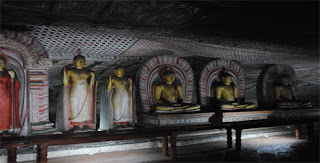Anuradhapura
Situated one hundred and twenty eight miles (205 km) north of Colombo, the ancient sacred Buddhist City of Anuradhapura hosts hallowed ruins of a grand civilization dating from the 5th century BC. Some of the most intricate irrigation systems of the ancient world are still functioning in Anuradhapura, the then grand capital city of man-made lakes, and great religious monuments designed by legendary kings. Touch the ancient stones of the Jetawana Stupa, along with the Abayagiri and Mirisawatte Chiatiya which are among the world’s tallest monuments, and you can imagine yourself going back in time more than two thousand years to an era where grand old kings ruled the Sinhala race from opulent palaces of sophisticated design. Stone palaces, monasteries and monuments, sculpture and architecture which were overgrown by jungle and then rediscovered, are yours to marvel over. There’s also the oldest tree in the world, the sacred Sri Maha Bodhi Tree which grew from a sapling of the tree under which the Lord Buddha attained Nirvana in India 2500 years ago! Today Anuradhapura is a UNESCO World Heritage Site. How did the ancients construct these massive monuments without technology or slaves, you will wonder. Trained elephants are said to have helped.
Polonnaruwa
Around the eleventh century AD, Polonnaruwa, in the North Central province of Sri Lanka, became the Sinhala capital city and was fortified to preserve its position. According to an ancient chronicle, the Culavamsa, the city was surrounded by three moats and high walls, and some of these remains are still to be seen. This city too has been declared a World Heritage Site, and today remains one of the best planned archaeological relic sites in the country, standing testimony to the discipline and greatness of the Kingdom's first rulers. A number of well preserved and fascinating ancient ruins dot this city ideal for connoisseurs of historical architecture or merely those who fancy a glimpse into times gone by.
Sigirya
Sigiriya is Ceylon’s beautiful Lion’s Rock fortress rising about 150 meters out of verdant plain in the Central Province, an ancient palace carved intricately out of a rock, designed for luxury loving by a king named Kashyapa. King Kashyapa moved the capital from Anuradhapura to Sigiriya around 473 AD after the construction of this elaborate palace fortress in the sky. Nominated as the Eight Wonder of the ancient world, Sigiriya is also a World Heritage Site and attracts a large number of visitors daily from around the 6th century judging from the “ Mirror Wall” which hosts one of the oldest collections of graffiti in the Sinhala language. Sigiriya is famous for its frescos of the “Maidens of the Clouds” examples of iconography of the ancient world, depicting beautiful maidens in heavenly abodes. Legends disagree about King Kashyapa who was supposed to be a patricide who dispossessed his brother to obtain the throne and then fortified himself at Sigiriya to avoid revenge. However anyone who sees the remains of this incredible medieval pleasure palace of gardens, swimming pools fountains and walkways, rising into the sky, agrees this is by an incredibly sensitive, , creative and artistic designer.
Dambulla
Eleven kilometres away from Sigirya and 135 km from Colombo. Dambulla hosts some of the most impressive cave Temple structures in Sri Lanka . The magnificent rock temple of Dambulla was built by King Valagamba in the 1st Century BC in gratitude for protection given by Buddhist monks during a prolonged exile . There are more than two thousand square meters of murals and 157 statues of all kinds to marvel over. For the paleontologists among us , there’s also a fascinating megalithic cemetery called Ibbankatuwa where buried human skeletons more than 2700 years old have been discovered, proving that people lived here in prehistoric times long before Buddhism was introduced to the island
Mihintale
The 9th century Mihintale hospital is said to be the oldest hospital in the world but this rocky hill is actually famous for a legend of Buddhist Arahat Mahinda( Mihindu in Sinhala) son of the most devout Indian Emperor Asoka, who converted King Devanampiyatissa who was actually out on a hunt, to be the first Sinhala Buddhist. Situated about 16 km from Anuradhapura, Mihintale means “Plateau of Mihindu”. There are 1,840 steps built 2,000 years ago to reach the Ambasthala Dagoba, which is a sacred dagoba built atop the mountain to mark this event. There are also many other interesting remains at Mihintale, including monuments, pavilions, image houses, hidden cave retreats and the remains of the ancient hospital.













